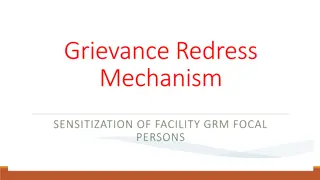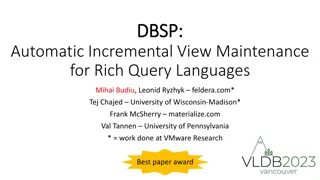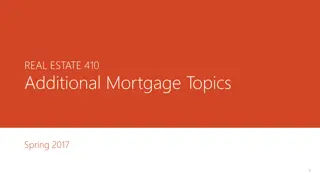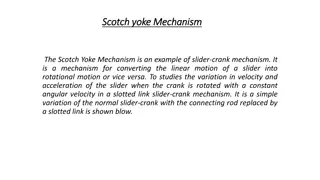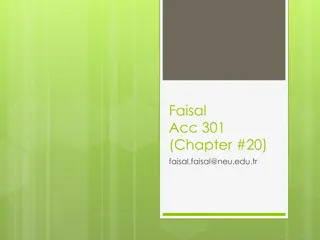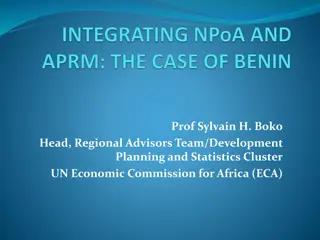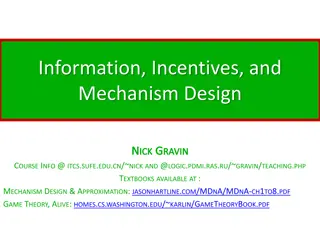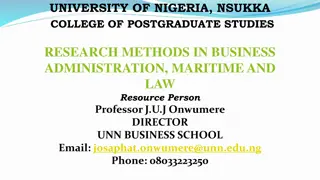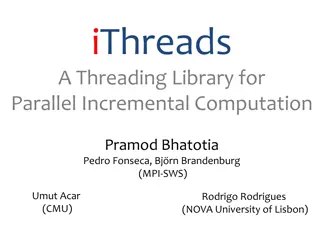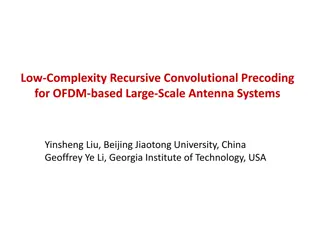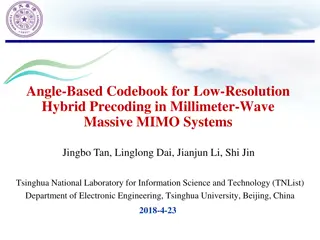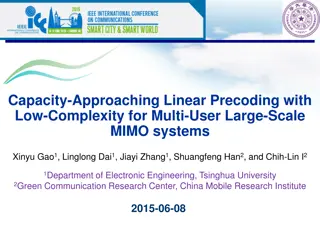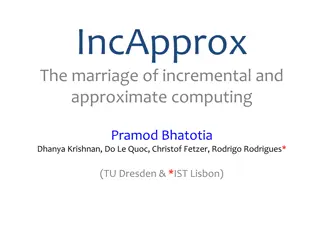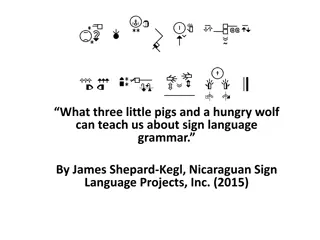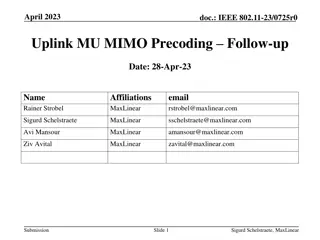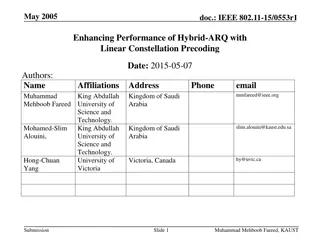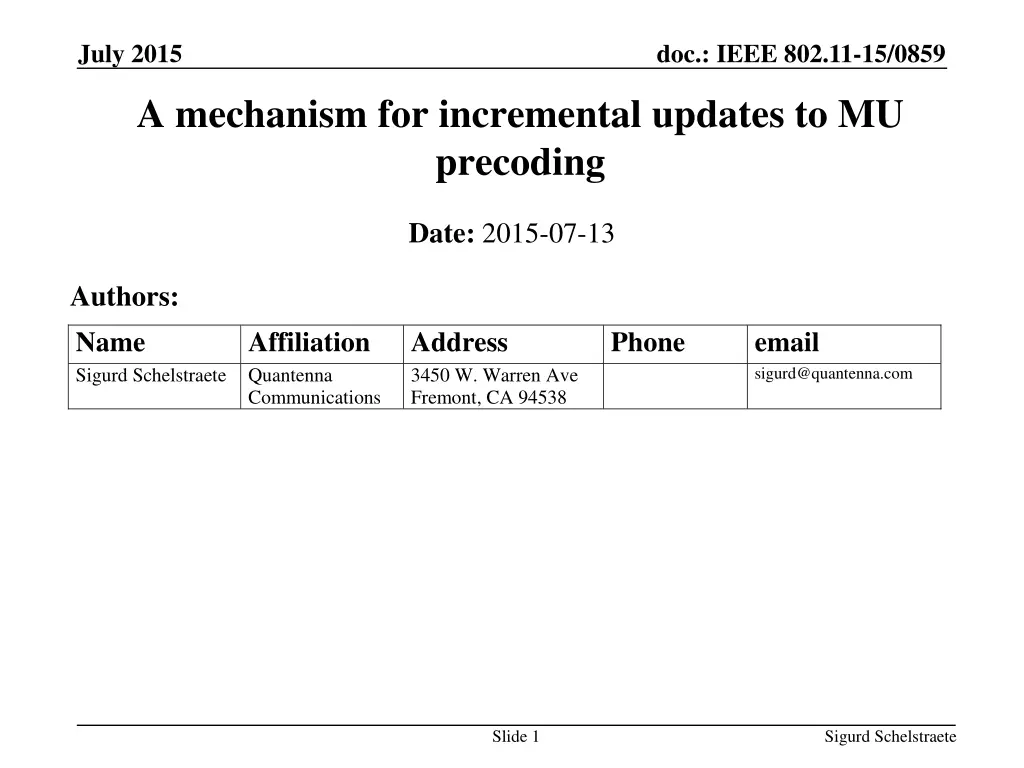
MU Precoding Incremental Update Mechanism
Explore a mechanism for incremental updates to MU precoding matrices in IEEE 802.11-15 standard. Discover a novel approach for updating precoding without sounding, based on information about interference channels at the receivers. Understand the principle, summary, and mathematical derivation of this approach to maintain MU-precoding effectiveness as channels change.
Download Presentation

Please find below an Image/Link to download the presentation.
The content on the website is provided AS IS for your information and personal use only. It may not be sold, licensed, or shared on other websites without obtaining consent from the author. If you encounter any issues during the download, it is possible that the publisher has removed the file from their server.
You are allowed to download the files provided on this website for personal or commercial use, subject to the condition that they are used lawfully. All files are the property of their respective owners.
The content on the website is provided AS IS for your information and personal use only. It may not be sold, licensed, or shared on other websites without obtaining consent from the author.
E N D
Presentation Transcript
July 2015 doc.: IEEE 802.11-15/0859 A mechanism for incremental updates to MU precoding Date: 2015-07-13 Authors: Name Sigurd Schelstraete Quantenna Affiliation Address 3450 W. Warren Ave Fremont, CA 94538 Phone email sigurd@quantenna.com Communications Slide 1 Sigurd Schelstraete
July 2015 doc.: IEEE 802.11-15/0859 Problem statement MU precoding matrices are calculated based on channel information at time of sounding MU precoding loses its effectiveness as the channel changes Interference no longer canceled Regular re-sounding and re-calculation of precoding matrices is needed Based on time interval Based on performance/interference observation Slide 2 Sigurd Schelstraete
July 2015 doc.: IEEE 802.11-15/0859 Updating the MU precoding without sounding A previous presentation [1] addressed ways to optimize the sounding based on receiver feedback This presentation introduces a possible different approach to keeping MU-precoding up to date No sounding Incremental updates directly to precoding matrix Based on information about interference channels at the receivers Slide 3 Sigurd Schelstraete
July 2015 doc.: IEEE 802.11-15/0859 Summary of the principle At initial time T0, the channel and precoding matrix are matched: ?0?0= 0 At time T1, the channel has changed ?0 ?1, leading to loss in orthogonality: ?1?0 0, with ?1?0~?(?) Using (only) knowledge of ?1?0, ?0 can be updated: ?0 ?1 such that: ?1?1~?(?2) Slide 4 Sigurd Schelstraete
July 2015 doc.: IEEE 802.11-15/0859 Summary of the principle Using knowledge of the interference channels allows a direct update of the precoding matrix that restores orthogonality (to first order) This incremental update can be repeated as often as desired NOTE: since this is a linear approximation, divergence will eventually happen Combine with lower frequency of sounding Slide 5 Sigurd Schelstraete
July 2015 doc.: IEEE 802.11-15/0859 Mathematical derivation For ?? users, initially we have: ?1 ?1?1 0 0 0 0 0 0 ?1 ??? = ??? ?????? Assume a small change in the channel (~?): ?1 ??? As a result: ?1 ??? ?1 ??? ?1 ??? = + ? ?1??? ?2??? 0 ?1?2 0 ?1?1 0 0 ?1 ??? 0 0 0 0 ?2?1 ????1 ?1 ??? = + ? ?????? ????2 ???? ?? ???????? 0 ???????? Slide 6 Sigurd Schelstraete
July 2015 doc.: IEEE 802.11-15/0859 Mathematical derivation (2) Note that ? ???? are exactly the interference channels observed at receiver ? Assume a change in precoding matrices of the same order of magnitude ~?: ?1 ???= ?1 ???+ ? ?1 Then: ??? ?1??? ?2??? 0 ?1?2 0 ?1?1 0 0 ?1 ??? 0 0 0 0 ?2?1 ????1 ?1 ???= + ? ?????? ????2 0 ?1 ??? ???+ ? ?2 ?1 + ? Slide 7 Sigurd Schelstraete
July 2015 doc.: IEEE 802.11-15/0859 Mathematical derivation (3) The term in order ? can be eliminated by choosing: ? ?1 ???= ?+ ? ?+ 1?? With: ?1 ??? ? = ?1??? ?2??? 0 ?1?2 0 ?2?1 ????1 ??= ? ????2 0 Slide 8 Sigurd Schelstraete
July 2015 doc.: IEEE 802.11-15/0859 Notes To first order, the update to the precoding matrix is only a function of the initial channel and the current interference channels No need for full channel information on the modified channel The number of streams in the MU transmission can be different from the number of streams in an NDP After the update: ?1 ??? ?1 ???~? ?2 Slide 9 Sigurd Schelstraete
July 2015 doc.: IEEE 802.11-15/0859 Simulation setup Channel is modeled as a complex-valued matrix Equivalent to frequency-domain analysis of single tone The changing channel is modeled as a gradual transformation from an initial to a final channel realization (see [1]) Results are compared with ideal precoding i.e. ideal reference where the precoding is always up to date relative to the latest channel state Slide 10 Sigurd Schelstraete
July 2015 doc.: IEEE 802.11-15/0859 Simulation assumptions After each sounding: Calculate a new precoding matrix Store the sounding channel information ? After each transmission: Collect the interference channel measurements from the receivers Calculate and apply the update to the precoding matrix Results are for a 4x4 AP and three 1x1 users Slide 11 Sigurd Schelstraete
July 2015 doc.: IEEE 802.11-15/0859 Results No precoding update Incremental updates to precoding Loss of precoding gain Precoding gain maintained Gradual degradation for longer time Slide 12 Sigurd Schelstraete
July 2015 doc.: IEEE 802.11-15/0859 Results combined with re-sounding No precoding update Incremental updates to precoding Loss of precoding gain Precoding gain maintained Slide 13 Sigurd Schelstraete
July 2015 doc.: IEEE 802.11-15/0859 Observations Incremental changes can keep precoding matrices up- to-date for much longer without re-sounding Behavior of SINR is much smoother, even as divergence sets in Re-sounding shows saw-tooth behavior Analysis is admittedly simplified and further study is required Slide 14 Sigurd Schelstraete
July 2015 doc.: IEEE 802.11-15/0859 Open issues: overhead The goal is to reduce the overhead The overhead involved in the incremental update approach should be less than that of frequent sounding Overhead is function of the amount of information and the messaging needed to convey the information Amount of information can be reduced: Quantization (we expect small numbers) Tone grouping Feedback on selected packets only (decimate in time) How low can overhead be and still be effective? Messaging information can be reduced E.g. Piggy-back feedback on ACK frame Slide 15 Sigurd Schelstraete
July 2015 doc.: IEEE 802.11-15/0859 Open issues: OFDM The analysis presented here is a matrix analysis Only single tone frequency-domain presented here OFDM may add to the complexity Avoid phase jumps between different transmissions due to different symbol alignment Some reference phase needs to be established Slide 16 Sigurd Schelstraete
July 2015 doc.: IEEE 802.11-15/0859 Open issues: format of channel information Simulations are based on full channel info Current 11ac provides only SNR and V in response to channel sounding Not clear if SNR and V alone are sufficient Maybe U-matrix is needed U-matrices are small for 1x1 and 2x2 clients Further analysis needed Slide 17 Sigurd Schelstraete
July 2015 doc.: IEEE 802.11-15/0859 Conclusions Re-sounding is the current mechanism to bring precoding matrices up to date We presented a different mechanism based on incremental updates of the precoding: Interference channel measurements contain all the information that is needed for a first-order update Information is available for free at the MU receivers Initial results show incremental changes can keep precoding matrices up-to-date for much longer without sounding A combination of infrequent sounding and incremental updates could be an alternative to frequent sounding Slide 18 Sigurd Schelstraete
July 2015 doc.: IEEE 802.11-15/0859 References [1] MU BFee Interference channel feedback , Sigurd Schelstraete, IEEE 802.11-15/0858 Slide 19 Sigurd Schelstraete

